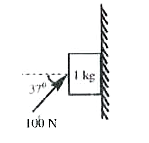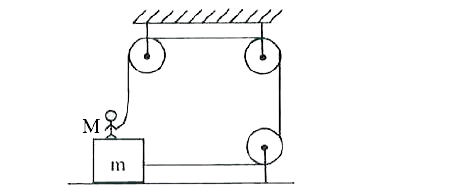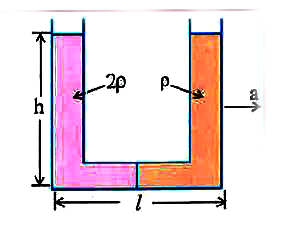A light cylindrical vessel is kept on a horizontal surface. Its base area is A.A hole of cross sectional area 'a' is made just at its bottom side. The minimum coefficient of friction necessary for sliding of the vessel due to the impact force of the emerging liquid is n×10−3. Find (a<<A). Given aA=2×10−3 Solution in Telugu
The correct Answer is:4
Step by step video, text & image solution for A light cylindrical vessel is kept on a horizontal surface. Its base area is A.A hole of cross sectional area 'a' is made just at its bottom side. The minimum coefficient of friction necessary for sliding of the vessel due to the impact force of the emerging liquid is n xx 10 ^(-3). Find (a lt lt A). Given (a)/(A) = 2 xx 10 ^(-3) by Physics experts to help you in doubts & scoring excellent marks in Class 11 exams.
Topper's Solved these Questions
- BOOK - AAKASH SERIESCHAPTER - FRICTION EXERCISE - LECTURE SHEET EXERCISE- II (STRAIGHT OBJECTIVE TYPE QUESTIONS)2videos
FRICTION
- BOOK - AAKASH SERIESCHAPTER - FRICTION EXERCISE - LECTURE SHEET EXERCISE- II (INTEGER TYPE QUESTIONS)1videos
FRICTION
- BOOK - AAKASH SERIESCHAPTER - FRICTION EXERCISE - LECTURE SHEET EXERCISE- I (LINKED COMPREHENSION TYPE QUESTIONS)5videos
FRICTION
- BOOK - AAKASH SERIESCHAPTER - FLUID MECHANICSEXERCISE - Questions for Descriptive Answers14videos
FLUID MECHANICS
- BOOK - AAKASH SERIESCHAPTER - GAUSS.S LAW EXERCISE - PROBLEMS (LEVEL - II)12videos
GAUSS.S LAW
Similar Questions
An eraser weighing 2N is pressed against the black board with a force of 5N. If the coefficient of friction is 0.4. How much force parallel to the black board is required to slide the eraser upwards
06:11View SolutionA body is pushed against vertical wall as shown. If the coefficient of friction between the body and the wall is 0.5, the magnitude of acceleration of the block is 10 K. Where K is
 05:01View Solution
05:01View SolutionMas of man is 'm' There is no friction between man and black But 'μ' is coefficient of friction between block and floor.

Maximum force that the man can exert on the rope so that the block does not slip on floor03:32View SolutionA U-tube of base length I filled with same volume of two liquids of densities ρ and 2ρ is moving with an acceleration a on the horizontal plane. If the height difference between the two surfaces (open to atmosphere)becomes zero,then find height h
 03:57View Solution
03:57View SolutionA charge q is placed at the centre of the open end of a cyclindrical vessel. Find the flux of the electric through the surface of the vessel.
03:57View SolutionA cylindrical vessel of area of cross section A is filled with a liquid up to a height H . A very small hole of area of cross section a is made at the bottom of the vellel. Find the time taken by the vessel to become empty.
02:45View SolutionA cylindrical vessel contains a liquid of density rho up to height h . The liquid is closed by a piston of mass m and area of cross section A . There is a small hole at the bottom of the vessel. The speed v with which the liquid comes out of the hole is
View SolutionA liquid is kept in a cylindrical vessel which is rotated along its axis. The liquid rises at the sides. If the radius of the vessel is r and the speed of revolution is n rotations/second, find the difference in height of the liquid at the centre of vessel and its sides.
View SolutionA light cylindrical vessel is kept on a horizontal surface. Its base area is A. a hole of cross sectional area a is made just at its bottom side (where a less than A). Find minimum coefficeint of friction necessary for sliding of the vesssel due to the impact force of the emerging liquid.
 View Solution
View SolutionA light cylindrical vessel is kept on a horizontal surface. Its base area is A. a hole of cross sectional area a is made just at its bottom sdie (where a ltlt A). Find minimum coefficeint of friction necessary for sliding of the vesssel due to the impact force of the emerging liquid.
04:19View SolutionA vessel of area of cross-section A has liquid to a height H . There is a hole at the bottom of vessel having area of cross-section a . The time taken to decrease the level from H_(1) to H_(2) will sec
03:31View SolutionA liquid is kept in a cylindrical vessel which is rotated along its axis. The liquid rises at the sides. If the radius of the vessel is r and the speed of revolution is n rotations/second, find the difference in height of the liquid at the centre of vessel and its sides.
01:30View SolutionA cylindrical vessel contains a liquid of density rho upto a heighth The liquid is closed by a piston of mass m and area of cross-section A. There is a small hole at the bottom of the vessel. Find the speed with which the liquid comes out of the hole
04:30View SolutionA cylindrical vessel contains a liquid of density ρ upto a heighth The liquid is closed by a piston of mass m and area of cross-section A. There is a small hole at the bottom of the vessel. Find the speed with which the liquid comes out of the hole
04:17View SolutionA cylindrical vessel contains a liquid of density rho up to height h . The liquid is closed by a piston of mass m and area of cross section A . There is a small hole at the bottom of the vessel. The speed v with which the liquid comes out of the hole is
03:34View SolutionA vessel of base area 100 cm x 60 cm and height 200 cm is completely filled with a liquid of density 1.1 xx 10^3 "kgm"^(-3) Ignoring the atmosphere pressure find the thrust at the bottom of the vessel
05:42View Solution

